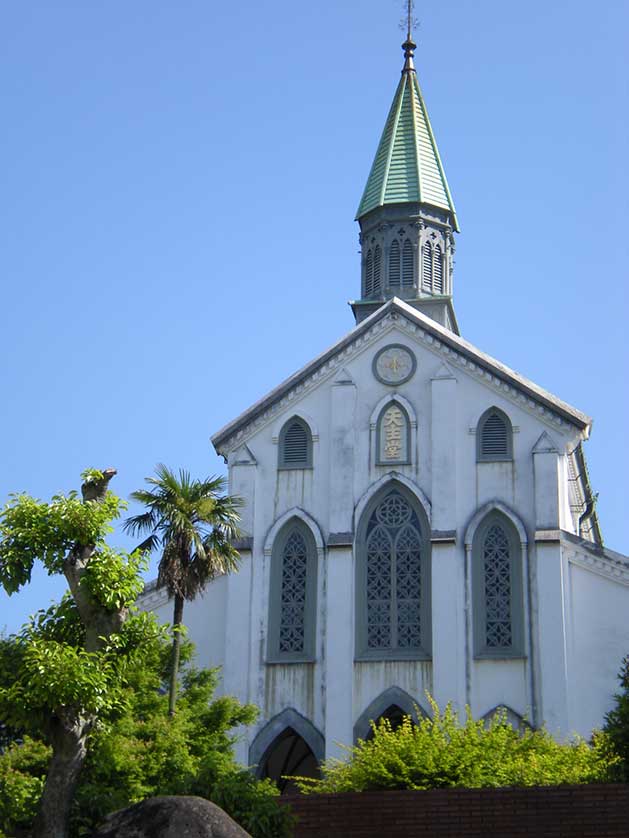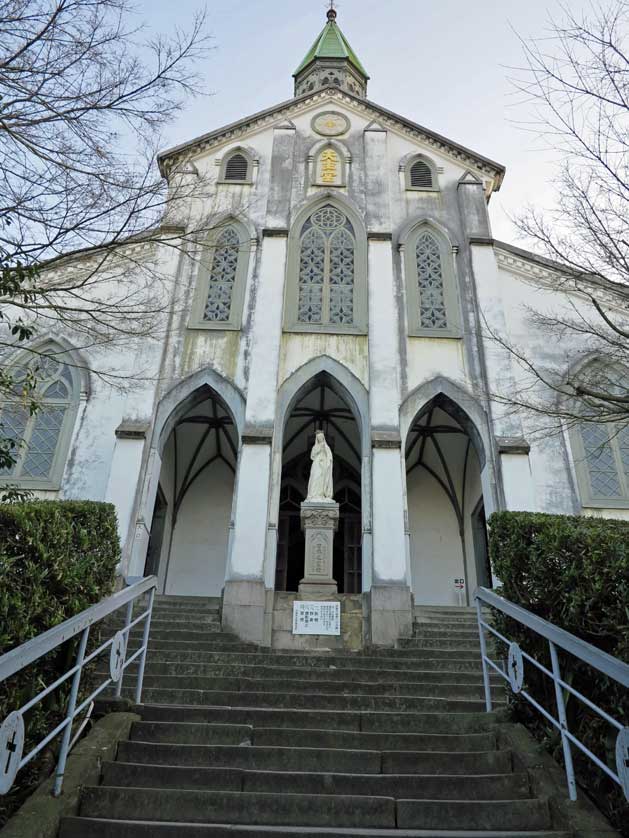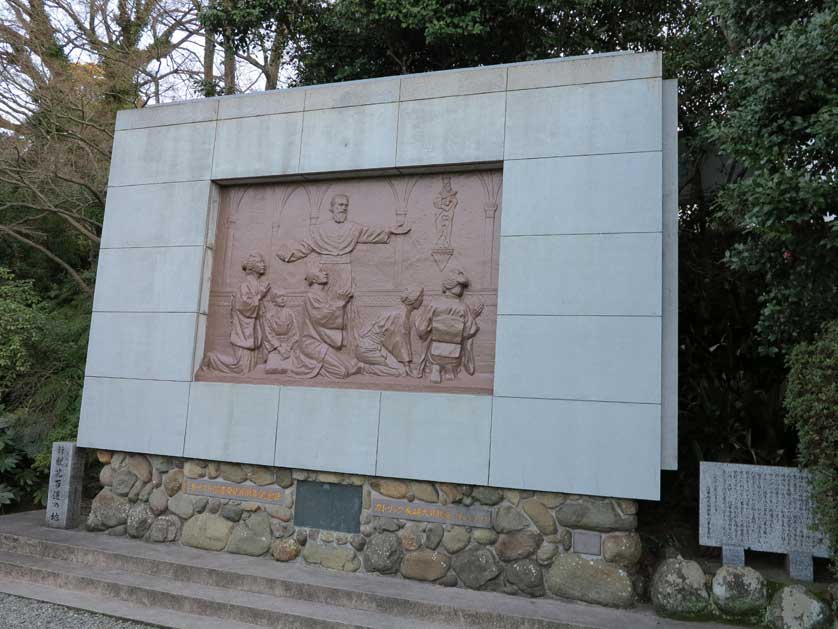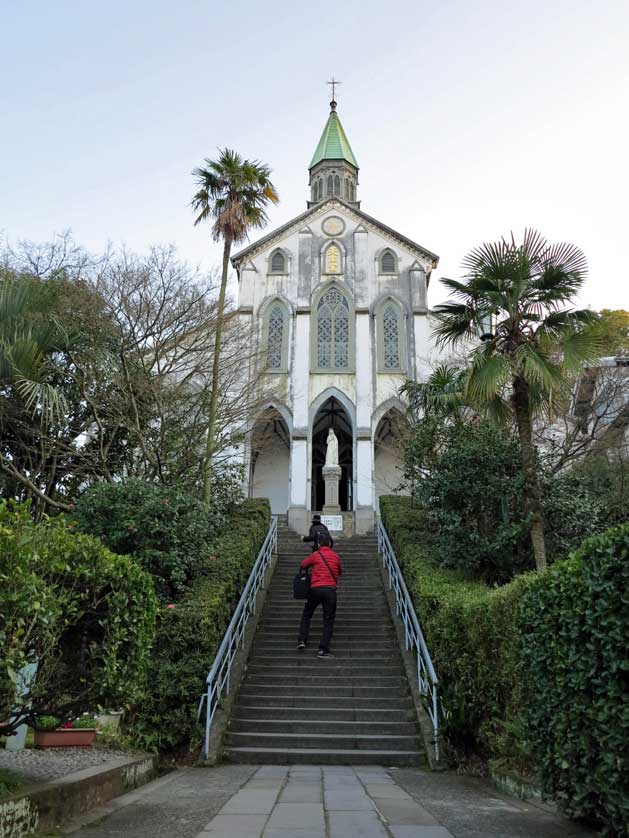Oura Catholic Church Nagasaki
- Published on : 14/02/2024
- by : Japan Experience
- Youtube

Nestled on a hill overlooking Nagasaki Bay, Oura Catholic Church stands as a testament to Japan's complex history with Christianity. Built in 1864, it is considered the oldest existing church in Japan and holds immense historical and cultural significance. This Gothic-style basilica, with its striking white exterior and soaring spire, not only serves as a functioning place of worship but also as a powerful symbol of religious perseverance and cultural exchange. As you approach this UNESCO World Heritage site, you'll be struck by its architectural beauty and the weight of its historical importance. Let's delve deeper into the fascinating story of Oura Church and discover why it's a must-visit destination in Nagasaki.
History and significance of Oura Church
The story of Oura Church is deeply intertwined with the tumultuous history of Christianity in Japan. Constructed by French priests Louis Furet and Bernard Petitjean, the church was initially built to serve the growing community of foreign merchants in Nagasaki following Japan's opening to the West. However, its significance goes far beyond its original purpose.
On March 17, 1865, a group of Japanese Christians from the nearby village of Urakami approached Father Petitjean at the church. In a moment that would become known as the "Discovery of the Hidden Christians," they revealed that they had secretly maintained their faith for over two centuries despite severe persecution. One woman whispered to the priest, "The heart (faith) of all of us is the same as yours. Where is the statue of Holy Mary?" This event marked a turning point in the history of Christianity in Japan.
The church played a crucial role in the revival of Christianity in Japan after the official lifting of the ban on the religion in 1873. It became a beacon for thousands of hidden Christians (Kakure Kirishitan) who had preserved their faith in secret for generations. The History of Oura Catholic Church is a testament to the resilience of faith and the power of cultural preservation.
Architecture and design features
Oura Church is a stunning example of Gothic Revival architecture, blending Western design elements with Japanese craftsmanship. The current structure, completed in 1879, replaced the original wooden church and features:
- A white stuccoed brick exterior that stands out against the lush surrounding greenery
- Tall, arched stained glass windows imported from France, flooding the interior with colorful light
- A high vaulted ceiling supported by wooden "rib vaults," showcasing the skill of Japanese carpenters
- An octagonal spire that dominates the Nagasaki skyline
- A roof made of sangawara pantiles, a traditional Japanese roofing material
The church's design beautifully marries European and Japanese architectural elements, creating a unique visual representation of the cultural exchange that occurred during Japan's opening to the West. As you explore the church, take note of how these different influences come together in harmony, much like the blending of cultures that occurred in Nagasaki during this period.

The discovery of hidden Christians
The "Discovery of the Hidden Christians" at Oura Church is one of the most significant events in the history of Christianity in Japan. For over two centuries, following the ban on Christianity in the early 17th century, thousands of Japanese Christians practiced their faith in secret, developing unique traditions and rituals to avoid detection.
When the group from Urakami approached Father Petitjean in 1865, it was a moment of profound revelation. These Kakure Kirishitan had maintained their faith through generations of secrecy and persecution, blending Christian beliefs with Buddhist and Shinto practices to survive. Their emergence at Oura Church marked the beginning of a new era for Christianity in Japan.
This event led to the gradual resurfacing of hidden Christian communities throughout the Nagasaki region. However, it also sparked a final wave of persecution, as the Meiji government, which had recently replaced the Tokugawa shogunate, initially continued the ban on Christianity. Many Christians from Urakami were exiled and tortured in an event known as "Urakami Yonban Kuzure" (Fourth Persecution of Urakami).
Today, a bronze relief in the courtyard of Oura Church commemorates this historic encounter, serving as a powerful reminder of the strength and perseverance of faith in the face of adversity. As you stand before this memorial, take a moment to reflect on the incredible journey of these hidden Christians and the role Oura Church played in their story.

Bronze relief commemorating the arrival of Nagasaki's Hidden Christians
Cultural and historical importance
Oura Church holds immense cultural and historical significance, not just for Christians in Japan, but for all those interested in the country's rich cultural tapestry. Its importance is reflected in several designations:
- In 1933, it became the first Western-style building to be designated a National Treasure of Japan
- In 2018, it was inscribed as part of the UNESCO World Heritage Site "Hidden Christian Sites in the Nagasaki Region"
- It is officially known as the Basilica of the Twenty-Six Holy Martyrs of Japan, commemorating the Christians executed in Nagasaki in 1597
The church serves as a bridge between East and West, embodying the cultural exchange that occurred during Japan's opening to the world in the 19th century. It stands as a symbol of religious freedom and the endurance of faith through centuries of persecution.
Moreover, Oura Church played a crucial role in the modernization of Nagasaki. As one of the first Western-style buildings in the city, it helped transform Nagasaki into a hub of international trade and cultural exchange during the Meiji period. Today, it continues to be a vital part of Nagasaki's identity, attracting visitors from around the world who come to admire its beauty and learn about its fascinating history.
Visiting Oura Church today
Visiting Oura Church today offers a unique opportunity to step back in time and experience a crucial part of Japan's religious and cultural history. Here's what you can expect during your visit:
- The church is open to visitors daily, with admission including entry to both the church and the adjacent Christian Museum
- Inside the church, you can admire the beautiful stained glass windows and the statue of the Virgin Mary that played such a crucial role in the discovery of the hidden Christians
- The Christian Museum, housed in the Former Latin Seminary and Former Archbishop's Residence, displays over 130 artifacts related to the history of Christianity in Japan
- A guided tour can provide deeper insights into the church's history and architectural features
- The church's hilltop location offers stunning views of Nagasaki harbor
To make the most of your visit, consider timing your trip to coincide with Mass or other religious events. While the church is primarily a tourist site, it remains an active place of worship, and attending a service can provide a more immersive experience.
Remember to dress respectfully and maintain a quiet demeanor, as this is still a functioning church. Photography is usually permitted inside the church, but be sure to check the current rules upon entry.
After your visit, take some time to explore the surrounding area. The church is located in the Glover Garden district, known for its beautiful Western-style houses from the Meiji period. It's a perfect opportunity to further immerse yourself in Nagasaki's unique history of cultural fusion.

Oura Church's UNESCO World Heritage status
In 2018, Oura Church was inscribed as part of the UNESCO World Heritage Site "Hidden Christian Sites in the Nagasaki Region". This designation recognizes the church's exceptional universal value and its significance in telling the story of Christianity in Japan.
The UNESCO listing includes 12 sites across the Nagasaki region, each representing a different aspect of the hidden Christian experience. Oura Church is particularly significant as it marks the end of the hidden Christian era and the beginning of the revival of public Christianity in Japan.
The World Heritage status highlights several key aspects of Oura Church:
- Its role in the discovery of hidden Christians
- Its importance as a symbol of the end of religious persecution in Japan
- Its architectural value as an example of the fusion of Western and Japanese styles
- Its historical significance in the broader narrative of Japan's modernization
This UNESCO recognition has further elevated Oura Church's profile, attracting more visitors and increasing awareness of this crucial chapter in Japanese history. As you visit, remember that you're not just exploring a beautiful church, but a site of global significance that tells a unique story of faith, perseverance, and cultural exchange.
Nearby attractions and practical information
Oura Church is situated in a historically rich area of Nagasaki, making it easy to combine your visit with other nearby attractions:
- Glover Garden: A short walk from the church, this open-air museum features Western-style houses from the Meiji period
- Hollander Slope: A picturesque stone-paved slope lined with Western-style buildings
- Confucius Shrine: Japan's only Confucian shrine, showcasing Chinese architecture
- Nagasaki Museum of History and Culture: Learn more about Nagasaki's unique history as a gateway to the West
Practical information for your visit:
- Access - Getting To Oura Catholic Church: The church is a 5-minute walk from the Ouratenshudo tram stop on line number 5
- Opening hours: 8:30 AM to 6:00 PM (last entry at 5:30 PM), slightly shorter hours in winter
- Admission fee: 1,000 yen for adults, includes entry to the church and museum
- Guided tours are available in Japanese, with English audio guides often available
- There's no parking at the church, so public transportation is recommended
Consider purchasing a Nagasaki Churches and Christian Sites Pass if you plan to visit multiple religious sites in the area. This can offer significant savings and includes several UNESCO World Heritage locations.
As you plan your visit to Oura Church, remember that you're not just seeing a beautiful building, but experiencing a pivotal piece of Japanese history. Take your time, soak in the atmosphere, and reflect on the incredible stories of faith and perseverance that echo through its walls. Whether you're a history buff, an architecture enthusiast, or simply curious about Japan's cultural tapestry, Oura Church offers a unique and deeply moving experience that will stay with you long after your visit.














